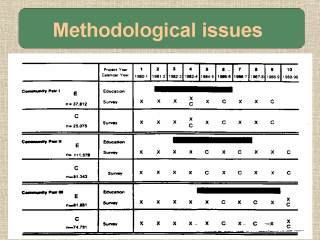 |
This slide illustrates the use of
matching communities, increasing the number of community pairs and increasing
the number of measurements in a community based trial to reduce the likelihood
of bias in the ascertainment of the outcome.
In the Minnesota Heart Health Program (Am J Public Health 1994;84:1383),
communities in each of three pairs, matched on important characteristics, were
allocated (not randomly) to experimental or control condition. In addition,
numerous measurements before, during and after the intervention were conducted
(see X and C) to allow the computation of more precise curves of change in risk
factors. |
